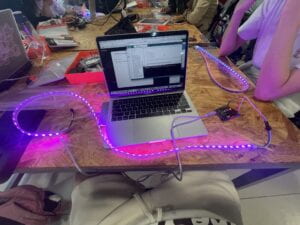Task 1:
I managed to connect the cable, which took me about 1 min. FastLed has already been downloaded before the recitation. From the material, I learnt to give supply for the larger pixel boards to glow the same way.

Task 2:
I lit up accordingly, the second light in purple. To be seen in the link.
On copying the code, I produced the scene below.
Task 3:
I tried to let all the pixels’ colors change with the sound but I can’t. And found out that it was the problem with the “constrain” function. On changing “constrain” to “map” . “map” was very useful a function that by ratio, it could turn a variable from one range to another correspondingly while “constrain” only limited a variable within the maximum and minimum. This is the situation before the change.
This is after.
It is such an ambiguity that I wanted it to be all purple and only bring changes on the saturability of purple.
/* This is a code example for Processing, to be used on Recitation 7
You need to have installed the SerialRecord library.
Interaction Lab
IMA NYU Shanghai
2022 Fall
*/
import processing.sound.*;
import processing.serial.*;
import osteele.processing.SerialRecord.*;
SoundFile sample;
FFT fft;
int bands =256;
float smoothingFactor = 0.2;
Serial serialPort;
SerialRecord serialRecord;
float[] sum = new float[bands];
int scale = 8;
float barWidth;
int W; //width of the tiles
int NUM = 255; //amount of pixels
int[] r = new int[NUM]; //red of each tile
int[] g = new int[0]; //green of each tile
int[] b = new int[NUM]; //blue of each tile
void setup() {
size(1024, 768);
background(255);
barWidth = 10*width/float(bands);
sample = new SoundFile(this, "Post Malone - A Thousand Bad Times.mp3");
// You can use this syntax and change COM3 for your serial port
// printArray(Serial.list());
// serialPort = new Serial(this, "COM3", 9600);
// in MacOS it looks like "/dev/cu.usbmodem1101"
//or you can try to use this instead:
fft = new FFT(this, bands);
fft.input(sample);
String serialPortName = SerialUtils.findArduinoPort();
serialPort = new Serial(this, serialPortName, 9600);
serialRecord = new SerialRecord(this, serialPort, 4);
serialRecord.logToCanvas(false);
rectMode(CENTER);
}
void draw() {
background(125, 255, 125);
fill(255, 0, 150);
noStroke();
fft.analyze();
//int n = floor(constrain(mouseX/W , 0, NUM-1));
//r[n] = floor(255);
//g[n] = floor(random(255));
//b[n] = floor(255);
for (int i = 0; i < 32; i++) {
// Smooth the FFT spectrum data by smoothing factor
sum[i] += (fft.spectrum[i] - sum[i]) * smoothingFactor;
// Draw the rectangles, adjust their height using the scale factor
rect(i*barWidth, height, barWidth, -sum[i]*height*scale);
r[i] = floor(255);
g[i] = floor(random(255));
b[i] = floor(255);
serialRecord.values[0] = i; // which pixel we change (0-59)
serialRecord.values[1] = r[i]; // how much red (0-255)
serialRecord.values[2] = g[i]; // how much green (0-255)
serialRecord.values[3] = b[i]; // how much blue (0-255)
serialRecord.send(); // send it!
}
}
void mousePressed(){//点击鼠标
if(sample.isPlaying()){//如果声音在播放
sample.pause();//暂停
}else{//否则
sample.loop();//播放声音
//play()函数只播放声音一次
}
}
But errors on behalf of the drive appeared. It said so:
SLF4J: Failed to load class “org.slf4j.impl.StaticLoggerBinder”.
SLF4J: Defaulting to no-operation (NOP) logger implementation
SLF4J: See http://www.slf4j.org/codes.html#StaticLoggerBinder for further details.
RuntimeException: Error opening serial port /dev/cu.usbmodem11301: Port busy